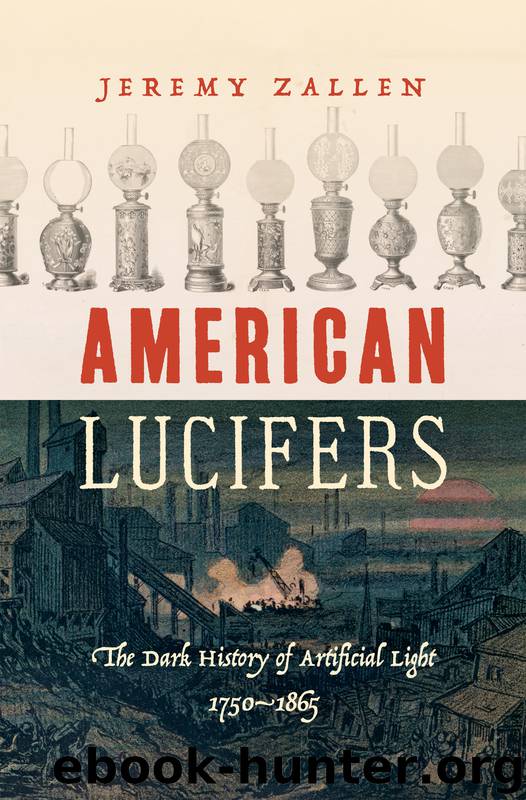American Lucifers by Zallen Jeremy;

Author:Zallen, Jeremy;
Language: eng
Format: epub
Publisher: University of North Carolina Press
Published: 2019-01-15T00:00:00+00:00
Filling and dipping a frame. Children filled these frames layer by layer at incredible speeds, slotting splint after splint into grooves cut in the wooden strips strung and stacked across the frame. Meanwhile, other children assisted the dippers (usually adult men) as they dipped the splint ends of completed frames in “compo”—a paste of gum, chlorate of potash, and phosphorus—and then flipped the frames to dip the other ends of the splints. Left: Filling a frame by hand. Engraving in Louis Figuier, Les merveilles de l’industrie (1860), 573. Right: Dipping a frame. Engraving in Louis Figuier, Les merveilles de l’industrie (1860), 575.
In Martindale’s, whenever ten-year-old Patrick Lovan or seven-year-old Richard Jones or any of the dozens of other boys finished filling a frame, they would “bring the clams up to the dipping slab and put them on the ground.” There, they received proof of their work as a “man gives each a ticket,” which they would later exchange for wages, around one shilling a week. Most of the fillers brought these wages home to their mothers, who might “give” their children a small share. Richard Jones’s “Mother brought him” to Martindale’s and “gives him 1d. The ‘missis’ pays him.” Arriving as early as four in the morning and working as late as nine at night in the winter, the boys worked a minimum of twelve and a maximum of seventeen hours each day, with an hour and a half for meals, filling their clamps at blinding speeds until the bell rang loudly for breakfast and dinner. Patrick Lovan testified that he “never has tea till he goes home. Does not even in winter. Is very hungry then.” Indeed, food and hunger were ever-present forces shaping how the children worked, struggled, and allied with one another. Lovan explained that he did not have “anything in his pocket to eat, because he eats all his dinner at dinner time. Some of the lads get bread and their tea fetched.” His story was not only one of poverty, but one of betrayal. Patrick’s mother used to send tea to her son, “but the lad who lived in the house and had to bring it used to eat it, and ‘Mother wouldn’t send it no more.’” Antebellum courts allowed minors, unlike adults, to break labor agreements at will, but the parents, poorhouses, orphanages, or other adults who contracted out the children they claimed, or from whom they demanded money in exchange for food and shelter, deeply circumscribed children’s freedom to find new work. And so while the children starved and stole food, sometimes hijacking another’s lifeline to resources outside the factory, most still had to persist in their alarmingly fast work.39
Both parents and employers could rely on the overlapping structures and desperations of class, age, gender, and hunger to force child workers to find their own nourishment, even if they had to steal or share among themselves. The “overlooker” at a Lambeth factory claimed that “boys are not beaten here,” but perhaps that was because hunger exacted its own, sufficient discipline.
Download
This site does not store any files on its server. We only index and link to content provided by other sites. Please contact the content providers to delete copyright contents if any and email us, we'll remove relevant links or contents immediately.
Learning SQL by Alan Beaulieu(6077)
Weapons of Math Destruction by Cathy O'Neil(5925)
Digital Minimalism by Cal Newport;(5457)
iGen by Jean M. Twenge(5213)
Sapiens by Yuval Noah Harari(5163)
The Age of Surveillance Capitalism by Shoshana Zuboff(4035)
Elon Musk by Ashlee Vance(3897)
Thing Explainer by Randall Munroe(3814)
Apollo 8 by Jeffrey Kluger(3539)
Future Crimes by Marc Goodman(3411)
The Science Book (Big Ideas Simply Explained) by DK(3158)
Who Can You Trust? by Rachel Botsman(3038)
I Live in the Future & Here's How It Works by Nick Bilton(2863)
Infinite Energy Technologies by Finley Eversole(2853)
Steve Jobs by Walter Isaacson(2777)
Dawn of the New Everything by Jaron Lanier(2698)
The Innovators: How a Group of Hackers, Geniuses, and Geeks Created the Digital Revolution by Walter Isaacson(2597)
Chernobyl by Serhii Plokhy(2450)
Ben Franklin's Almanac by Candace Fleming(2399)
